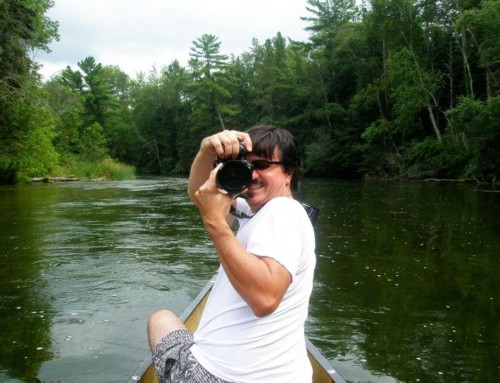The Mississippi River cuts a thousand mile path through the middle of the U.S., running through a variety of climates and micro-climates. In spite of this, there’s a lot of similarity in the types of plants and animals that live in or near the river. While you may not see Spanish moss in Minnesota, for example, you’ll find catfish just about anywhere along the Mississippi.
Plants
The Mississippi River is lined with dense forests that run along most of its length (although not as dense as they were a century ago). Close to the river, hardwood trees reach up toward the sky, providing cover for shade-loving plants. The plants in the floodplain forest are uniquely adapted to tolerate periods that are sometimes wet and sometimes dry.
Along the Upper Mississippi, the floodplain forest consists mostly of silver maple, river birch, bur oak, green ash, hackberry, cottonwood, and swamp white oak. Below the canopy, you’ll find buttonbush, plus plants like nettles, gray-headed coneflower, ostrich fern, and cardinal flowers. As you travel south, the floodplain forest is dominated by cottonwood, hackberry, pecan, elm, and willow.
The bluffs along the upper river are dominated by trees like oak, hickory, and walnut. You can still find a few remnants of the prairies that used to be common atop the bluffs (sometimes called “goat prairies”), like the ones with impressive views at Rush Creek State Natural Area north of Ferryville, Wisconsin.
Along some sections of the Upper Mississippi River, you can even find a few examples of a rare and fragile ecosystem called algific talus slope. A throwback to the Ice Age, this ecosystem still exists today near the base of north- or east-facing bluffs. Sinkholes and underground ice caves vent cold air well into the summer months through cracks in the rocks on the sides of bluffs. This uncommon ecosystem supports a number of rare plants and animals, including the northern monkshood wildflower, cherrystone drop snail, and Pleistocene vertigo snails. In some places, this ecosystem also produces features sometimes called petrified waterfalls, which are basically above-ground stalactites that formed by the interaction of algae with certain minerals. A few examples of algific talus slope exist in the Driftless Area National Wildlife Area and in property recently purchased by the Mississippi Valley Conservancy.
In the backwaters, you’ll find plants that grow well in shallow water, like wild rice, cattails, bulltongue arrowhead, American lotus, and waterlily.
TIP: If you want to tell the difference between a lotus and a water lily, lotuses bloom in August and the flower stands upright; lily blooms float on the water. You can thank me later.
The river valley also has a variety of wetlands. Fens and bogs (two types of peatlands) are common in the Headwaters Region of northern Minnesota. Fens have a high water table, peat up to six feet thick, and a current moving through them; they attract a wide range of plant life. Bogs are highly acidic and lack water movement, with a peat layer that can be as much as thirty feet thick.
The bogs—the Ojibwe’s pharmacy, as Louise Erdrich wrote in Books and Islands in Ojibwe Country—have several unique plants, including tamaracks (a deciduous conifer) that turn bright gold in fall. You’ll also find Labrador tea (Ledum groenlandicum), and yes, those leaves do make a pretty good beverage. Orchids also thrive in the bogs, including the showy lady’s slipper—a stunning blue orchid—that is Minnesota’s state flower; it blooms from early June to mid-July, along with a variety of other orchids.
Swamps also abound along the Mississippi. In the river’s southern reaches, you’ll find swamps where the most common tree is the bald cypress, but you’ll also find tupelo gum, swamp blackgum, swamp red maple, and green ash. These swamps also include unique plants called epiphytes, which includes bromeliads (like Spanish moss) and orchids. These plants wrap themselves around the trunks and branches of the trees and get most of their nutrients directly from the air instead of through the soil.
Coastal marshes form at the mouth of the Mississippi River, where it meets the Gulf of Mexico. These are areas where the fresh water begins to mix with salt water and the land is newer, composed of sediments deposited by the Mississippi River over the last few centuries. Grasses like roseau cane are common in the coastal marshes. Louisiana’s coastal marshes are now eroding faster than they are being built because of human activities like oil and gas exploration and the channelization of the river between levees.
Animals
There is a much greater range of animal life along the Mississippi River than you might think. Deer are ubiquitous; it is the animal (other than squirrels) that you are most likely to see (or hit with your car).
If you are paying attention and have some luck, you may also catch sight of beaver, muskrat, otter, raccoons, turtles (maybe even a large snapping turtle), and fox. If you are really lucky, you might spot mink, a timber rattlesnake, or a massasauga rattlesnake. Rattlesnakes are very timid and most likely will flee if you come across them, but they will strike out of self-defense if they are cornered or surprised. The timber rattlesnake is listed as a threatened species under the Endangered Species Act; kill one and you could go to jail.
There are quite a few animals you might hear but probably won’t see, like coyotes and bobcats. Black bear are increasingly common in some areas, like the forests of Minnesota, Wisconsin, Mississippi, and Arkansas.
If you are a birder you probably already know about the Mississippi River flyway. For the rest of you, a few facts: 40% of all North American waterfowl migrate along the Mississippi River; 326 species of birds—one-third of all birds on the continent—migrate through in the spring and fall.
Among the migrants are bald eagles in winter, song birds and pelicans in spring, and tundra swans in late fall. Species that are fairly easy to spot include hawks, turkey, peregrine falcons, great blue heron, egrets, geese, ducks, cormorants, and turkey vultures. While the number of bald eagles increases dramatically in winter (they like to fish in the open waters around the dams), many bald eagles now nest along the Mississippi River, so in some places (like around the backwaters south of Brownsville, Minnesota), you can see bald eagles any time of year.
Even with the dramatic man-made changes to the ecology of the Mississippi River, fish still abound—260 species live in the river or one-quarter of all fish species in North America. Many species are threatened (pallid sturgeon and several species of mussel such as the Higgins’ eye pearly mussel), but fish that are still common include fishermen’s favorites like crappie, largemouth bass, striped bass, sunfish, walleye, catfish, white bass, and bluegill, as well as carp, suckers, and buffalo fish.
The river is also home to four ancient species of fish: the bowfin, sturgeon, paddlefish, and alligator gar; the latter three are threatened or endangered. And, of course, there are plenty of turtles and mussels. All of these are under pressure from invasive species like zebra mussels and the invasive silver and bighead carp, some of which jump high out of the water when disturbed.
TIP: You can see many of these fish up close and personal at the National Mississippi River Museum and Aquarium in Dubuque, Iowa.
Community-supported writing
If you like the content at the Mississippi Valley Traveler, please consider showing your support by making a one-time contribution or by subscribing through Patreon. Book sales don’t fully cover my costs, and I don’t have deep corporate pockets bankrolling my work. I’m a freelance writer bringing you stories about life along the Mississippi River. I need your help to keep this going. Every dollar you contribute makes it possible for me to continue sharing stories about America’s Greatest River!
Continue to Flooding on the Mississippi River…
Back to Mississippi River Geology…
© Dean Klinkenberg, 2011,2018


